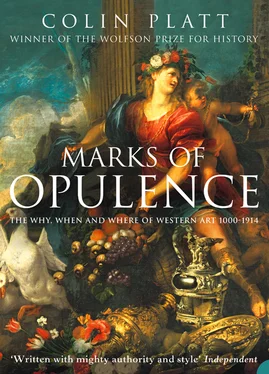‘Civilization both in the East and the West was visited by a destructive plague’, wrote Ibn Khaldun of the first onset of the Black Death, ‘which devastated nations and caused populations to vanish. It swallowed up many of the good things of civilization and wiped them out … The entire inhabited world changed.’ 1 He was right, of course. Yet he could not have known, as a contemporary witness of the Great Pestilence, just how long-lasting those changes would prove to be. Reduced by at least a third in 1347–50, Europe’s populations either stabilized at that level for the next 150 years or fell still further. And while some of that reduction was arguably inevitable – a necessary purge following centuries of growth, bringing people and resources back in balance – what followed was a recovery so sluggish and so unequal as to put a blight on the economy for generations. Downsizing a labour force is effective only if what is left provides a springboard for future growth. Yet there was to be little growth of any kind before the 1480s at earliest. And the real tragedy of the Black Death, in the longue durée , was Western society’s lamentable failure to rebuild.
That failure was more complete in some localities than in others. Norway, at one extreme, lost 64 per cent of its pre-plague population between 1348 and 1500; whereas England, over the same period, lost nearer 50 per cent, and others went down by just a third. These are estimates only, of which the accuracy has often been disputed. But even if wrong in detail, what the figures clearly show are conspicuously low replacement rates across the population as a whole, frequently barely adequate for survival. The most successful urbanized economies of the first half of the fifteenth century were Burgundian Flanders and Republican Florence. Both were especially attractive to skilled immigrants and, in part as a result, became the leading contemporary capitals of the arts. Yet the population of the Flemish cities, for all the magnetism of their wealth, continued to drift downwards through much of the fifteenth century, with no recovery of any substance before the end of it. And in Florence likewise, whereas population losses had bottomed out by the 1420s, there was then no upward movement for half a century at least, so that there were still markedly fewer Florentines in 1500 than there had been in 1347.
A severe and exceptionally long-lasting demographic collapse was thus the shared experience of almost all late-medieval communities in the West. And very little of what happened after the Black Death makes sense without reference to the pestilence. However, bubonic plague was just one element of a general retreat which, while certainly triggered by the Black Death in 1347–50, very rapidly developed its own momentum. That first outbreak of the disease had killed huge numbers, with some death-counts rising as high as 80 per cent even in remote rural communities. While increasingly an urban phenomenon, killer plagues then returned repeatedly for over three centuries before vanishing unaccountably in the 1700s. Yet plague was never the only – nor even the principal – population curb in the Western towns and cities it most afflicted. In late-medieval Europe, it was less bacteria that frustrated growth than full employment.
In practice, plague survivors were in great demand in every sort of occupation, and the jobs-for-all bonanza of the Black Death’s aftermath was self-perpetuating. Working women, in what is sometimes seen as their original ‘Golden Age’, were free at last to choose when to stop work and start a family. And in opting to marry later, only then setting up households of their own, they also cut the numbers of their children. Europe has many cultures, and neither the marriage patterns nor the household formation systems of North and South were then – or have ever been – the same. But whereas Mediterranean brides continued to find their partners before the age of twenty-one, post-plague northerners usually waited until their mid-twenties to make a match, and not infrequently stayed single out of choice. Where women married late and were prone to die in childbirth, where infant mortality was chronically high, where breast-feeding postponed conception for two years or more, and where life expectations, already low before the plague, fell still further, populations soon stopped growing. In short, the key demographic variable after the Black Death was arguably not mortality but nuptiality.
‘People are not poor because they have large families’, wrote a student of household systems in modern India. ‘Quite the contrary, they have large families because they are poor.’ 2 And, in contrast, it was the relative affluence of individual plague survivors – and particularly, in this context, of independent farmers and their wives – which enabled them to settle for smaller nuclear families with fewer children. Traditional extended family systems, while still very much alive in the Third World today, were dying out in north-west Europe by 1400. And those comfortably-off English yeomen and their womenfolk who built the solid oak-framed farmhouses of the fifteenth-century Kentish Weald, were never in the business of offering accommodation to all and sundry. In their big open halls – relics of a life-style once entirely led in common – the uncles and aunts, nephews and nieces, grandparents, in-laws and cousins far and near, came together only, as it were, for Sunday lunches.
It was thus high levels of employment and good wages in the West which enabled that critical threshold to be crossed between a ‘situation where people cannot afford not to have children [and] one where they cannot afford to have many of them.’ 3 And paradoxical though it may sound, it was this new post-plague prosperity that, by discouraging large families, helped put off demographic recovery. Another token of private affluence, of which the outcome was the same, was the single-person household of the unmarried working woman or merry widow. In Florence in 1427, one in four adult women were widows, and many had doubtless chosen to remain in that condition, coming to view the death of older spouses as liberation: ‘as if a heavy yoke of servitude ( un grave giogo di servitu ) had been lifted from their backs’, observed Lodovico Dolce in the next century. 4
Ensnared by Mamma’s cooking, Florence’s affluent bachelors had been reluctant to leave home before their early thirties, or even later. And fathers who had married tardily were another obvious reason why European city populations, even before the plague, had always found it difficult to replace themselves. Traditionally, the gap had been filled by immigration from rural areas. But whereas new recruitment remained steady in the half-century following the Black Death, as the smaller and more marginal settlements lost out to the towns, that pool was drying up by 1400. Newly prosperous peasant families, with too much land at their disposal and too little labour of their own, remained (and kept their children) in their localities. For if the populations of big cities risked extinction in post-plague times, so too – and often more so – did village communities. The Tuscan city of Pistoia was a near-neighbour and dependency of Florence. And Pistoia’s contado (rural territory) had been haemorrhaging population since the late thirteenth century, losing more than 70 per cent of its pre-plague maximum by 1400. That figure conceals huge differences between well-situated lowland villages, which continued to keep up numbers, and remote hill-top communities already in the advanced stages of disbanding. Nevertheless the fact remains that Pistoia the city – regular plague-trap though it was – held its strength marginally better than the contado. When surveyed in 1415, Pistoia’s population had fallen from around 11,000 shortly before the Black Death to just below 4000, or a loss of some 65 per cent. 5
Читать дальше












